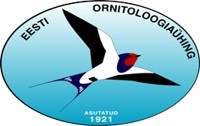Direct stream | News | Forum
Stream for mobile devices: iPhone, iPad; Android, VLC
The capercaillie camera is installed at a capercaillie lek site in Võrumaa that has been known already for a long time. During monitoring up to five cocks have been counted there. With the aid of the camera we can confirm this or have a more exact number. The camera however is in one definite place, from where you cannot see far and the direction of the sound cannot be determined from the camera. So the camera does not really replace monitoring but hopefully will complement it.
The installation of the camera system took place in March. We did not see capercaillies at the time, but we found some capercaillie tracks about

Capercaillie tracks on early spring snow, for comparison the tracks of Jaanus.

In some places feathers of capercaillie males could also be found. Were they there from the attack of an predator?

At the installation of the camera some were happy to teach from the ground; Olev and Omar offer recommendations.

Who did not understand all about the finer points of electronics had to get up into the tree. Urmas.
 Solar panels about one third more powerful than at nest cameras, those are lifted closer to the sun.
Solar panels about one third more powerful than at nest cameras, those are lifted closer to the sun.
The capercaillie camera allows us to observe the lek rituals of the capercaillies until the end of May and to see and hear what happens there later as well. It is a brand new camera that the operator can pan, tilt and zoom. To follow the capercaillies moving around on ground.
 The camera is visible but the capercaillie do not pay much attention to it, even walk just under the camera.
The camera is visible but the capercaillie do not pay much attention to it, even walk just under the camera.
While the activities in the nest cameras are in more or less limited spots – the nest – then the capercaillie lek includes a significantly larger area, and a moveable camera is the only possible way to transmit the capercaillie lek. But we cannot avoid that the capercaillies may decide to start the lek at the back of the camera or behind the trees and there we cannot see. Similarly we cannot see the entire surroundings at one time which means that some specimens may visit the area without us seeing them. Several cocks can also display in different directions and then we must accept the operator’s choice.
The capercaillies are not active in camera view during daytime and night, but arrive at the lek site in the evening at sunset. Evidence of this is the flying in to the lek site with a great bustle. Some evenings they may also arrange tournaments. In the morning the capercaillie lek begins 2-3 hours before sunrise, so quite early (for western Europe observers it is even more early). The capercaillies can then be seen and heard in the camera until mid-morning, when the cocks head away from the lek site to rest and feed. Each capercaillie male has its own territory in the lek but when the females come into the lek a fight may develop because of them.
 The territory of one cock directly faces the camera. Screencap from the camera by Hagnat.
The territory of one cock directly faces the camera. Screencap from the camera by Hagnat.
In addition to the capercaillies other bird species typical for pine tree stands may also come into hearing distance of the camera, such as crossbills, ravens and crested tits; with luck in the night hours the Ural owl or the pygmy owl can be heard! From time to time sounds from human activities can be heard in the capercaillie camera: noise from the road, aeroplanes passing across, felling (outside the felling truce period) and sounds from the nearby Defence Forces training field. The exercises of the Defence Forces can be quite disruptive but the birds and animals living here are used to it and don’t pay particular attention to the banging. The din may rather disturb those who visit the site through the camera. Within the protected area there are no military exercises but the nearest point of the boundary is about a kilometer distant.
Urmas Sellis, Jaanus Tanilsoo, Olev Lüütsepp and Omar Neiland took part in the installation of the camera and the Looduskalender forum people also keep their eyes on the capercaillie camera.
The Capercaillie camera is the result of the collaberation of many organisations: BirdLife Estonia (Estonian Ornithological Society) bought the camera, the Kotkaklubi (Eagle Club) and Omar set it in working order and keeps an eye on it, EENet helps with server power and Looduskalender.ee mediates the news. Selected video cuts can be seen on the Estonian Ornithological Society’s capercaillie page or the BirdLife Estonia’s video collection. Estonian Environmental Investments Center (KIK) supports the installation of the camera and the Bird of the Year project.
There is more to read about the capercaillie as the Bird of the Year 2018 on the page of the Bird of the Year.
The camera system is set up so that at night all power consumers are switched off and on again in the morning. This allows the power consumption in early spring to be significantly reduced and the batteries need not be replaced. Solar panels work well as long as there is not snow on them and the sun shines. In the longer days we hope to be able to have transmission day and night. It can be regulated from a distance without having to visit the location. The camera is a new AXIS P5635-E Mk II PTZ, which has a greater power consumption than the nest cameras. But solar panels and batteries are in use to a greater extent here. The microphone is a little bit away from the camera to avoid having to hear the buzz of camera movement. The microphone cannot be moved (directed) which means that happenings at the right hand side of the camera can be heard slightly better but there is no significant difference. The voice of the capercaillie is not very strong, other sounds may easily muffle it. The microphone was built by Omar himself.
The data transmission goes by way of the 4G mobile network. Since the coverage of mobile networks is primarily aimed at settlements, distribution in the forest is not the best although we use extra aerials. Controlling the camera becomes difficult when people start using their mobile devices and the network resource of a particular mobile tower network capacity is distributed between different users. The speed drops and the camera no longer responds to the operator’s commands. Fortunately humans and the capercaillies have different peak activity times. Through the 4G network the camera image reaches the EENeti server. In the server sharing the image to thousands of viewers all over the world takes place who want to take part of what is going on at the lek ground.
We can use the YouTube stream service when the camera does not have to be disconnected at night.
The minimal costs for keeping the camera running are this year covered by KIK, but we cannot buy equipment with this support. Thus the Estonian Ornithological Society had to find a loan solution for buying the camera system. There is a plan however to launch a project to recover the purchase money for the camera and add an additional power source so that power shortage would not be a problem in the future. The aim is to use the capercaillie camera for several years. If in the same lek or for something else will be clear at the end of the season.
As far as we know there is no capercaillie camera elsewhere at the moment.
Engaged in the enterprise.:
Supporter:





